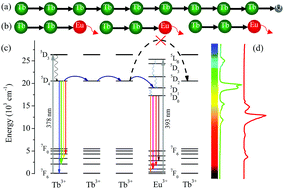Eu3+-Doped glass ceramics containing NaTbF4 nanocrystals: controllable glass crystallization, Tb3+-bridged energy transfer and tunable luminescence
Abstract
Herein, hexagonal and cubic NaTbF4:Eu3+ nanocrystals embedded in transparent glass ceramics were successfully synthesized via a conventional melt-quenching technique followed by glass crystallization for the first time. Structural and spectroscopic characterizations evidenced the composition-dependent crystalline precipitation and the partition of Eu3+ dopants into the NaTbF4 host. In particular, the energy transfer mechanism from Tb3+ to Eu3+ was systematically investigated by photoluminescence spectra and decay curves, confirming that the energy transfer chain of Tb3+ → (Tb3+)n → quenchers in NaTbF4 nanocrystals was replaced by Tb3+ → (Tb3+)n → Eu3+ with the incorporation of Eu3+. The discrepant luminescence behaviors in terms of on-phase transformation were also studied. Furthermore, tunable emission could be achieved by merely adjusting the content of Eu3+, producing distinguishable emissions. As a consequence, it could be expected that NaTbF4:Eu3+ nanocrystals embedded in glass ceramics are promising candidates for applications in lightings and displays.



 Please wait while we load your content...
Please wait while we load your content...